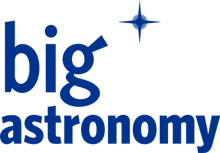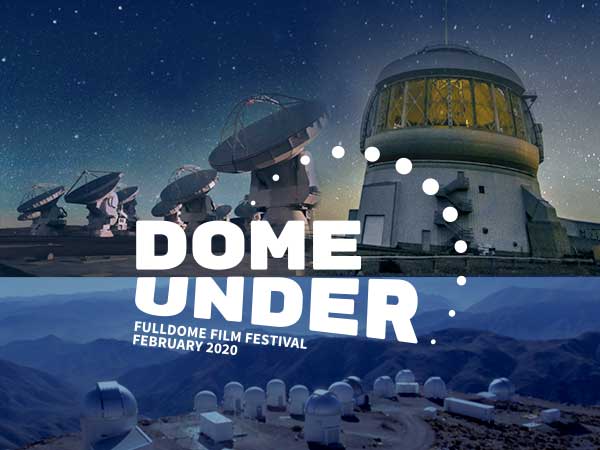Big Astronomy wins “Best Astronomy Education” Award in the Dome Under Fulldome Film Festival.
Melbourne: The Dome Under Fulldome Film Festival hosted its first planetarium film fest in Melbourne, Australia, on February 8 – 9. Big Astronomy: People Places Discoveries, a planetarium film funded by the National Science Foundation (NSF) and produced by the California Academy of Sciences in collaboration with AUI and others won the Best Astronomy Education Award. “It’s a great honor for Big Astronomy to receive recognition from Australia’s first-ever fulldome festival! We had some fierce competition for the Best Astronomy Education Award, so we really appreciate being recognized by the jury for our work. It was also great to hear from festival attendees how they felt about the show’s depiction of the people who work at Chile’s great observatories—as diverse role models for the next generation of young scientists and engineers. That’s something we worked hard on, and it’s rewarding to know that people got the message,” says film Writer and Director Ryan Wyatt.
The film fest jury describes Big Astronomy as an “elegantly produced film” that “showcases the diverse collaboration of scientists that open our minds to the expanse of the cosmos. Extraordinary footage and engaging talent.”
With support from NSF-Advancing Informal STEM Learning (AISL) program, Associated Universities Inc. (AUI) partnered with Michigan State University, the California Academy of Sciences, Astronomical Society of the Pacific, Association of Universities for Research in Astronomy, NSF’s National Optical-Infrared Astronomy Research Laboratory including Cerro Tololo Inter-American Observatory and Gemini Observatory, and the Atacama Large Millimeter/submillimeter Array to complete the $2 million project.
Big Astronomy is set in Chile where the dry, dark, sky, and remoteness creates an ideal site to observe the universe. By the year 2022 it is expected that nearly 70% of the world’s ground-based observing infrastructure will be located there, and the US and other countries are investing billions of dollars in astronomy in Chile. Big Astronomy introduces audiences to the wide variety of personnel involved in advancing astronomical discovery. “When people think of astronomy they often imagine astronomers peering through telescopes,” says AUI President, Adam Cohen, “they are unaware of the STEM village it takes to make exploration of the cosmos possible.” Big observatories today employ electrical and mechanical engineers, technicians, data analysts, machinists, heavy equipment operators, maintenance personnel, artists, cooks, etc. Each of these individuals play an important role in making astronomical discoveries possible.
“AUI is proud to be part of this excellent team,” says Tim Spuck, AUI Director of Education and Public Engagement and Principal Investigator (PI) for Big Astronomy, “Together we produced a product that will impact and inform millions globally about the NSF observatories in Chile and the diverse STEM careers at these large science facilities.” The Dome+ model being developed by the team will also support engagement beyond the planetarium show through a dynamic web portal and curricular resources. “Planetariums are wonderful places to learn and introduce people to the wonders of the universe. However, people only get to visit for a short period of time. Providing these cohesive resources will allow us to engage visitors well beyond their planetarium visit. By studying how they navigate through the resources, we will better inform future planetarium projects,” states Shannon Schmoll who leads the Big Astronomy research effort at MSU.
The portal will include learning activities, interviews with observatory personnel, and a schedule of live virtual sessions with those working at the observatories. The curricular resources and planetarium show will be made available in both English and Spanish for dissemination in the US and Latin America. Renae Kerrigan at Peoria Riverfront Museum commented, “It’s exciting to work with a great team of professionals to develop a suite of educational products that will be used by the planetarium community and schools around the world.” Big Astronomy will be released globally on May 2, 2020. Check out www.bigastronomy.org for more information and to find a planetarium near you.
The Big Astronomy Leadership Team includes Ryan Wyatt and Molly Michelson at California Academy of Sciences, Dr. Shannon Schmoll, Dr. Katie Hinko and Dr. Jesica Trucks at Abrams Planetarium-Michigan State University, Vivian White at Astronomical Society of the Pacific, Renae Kerrigan at Peoria Riverfront Museum, Tiffany Stone Wolbrecht at Ward Beecher Planetarium-Youngstown State University, Shari Lifson at Association of Universities for Research in Astronomy, and Yasmin Catricheo and Tim Spuck at Associated Universities Inc.
For additional information, please contact Tim Spuck, Big Astronomy PI and AUI Director of Education and Public Engagement at [email protected].

